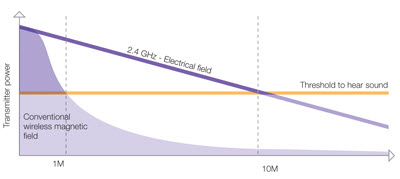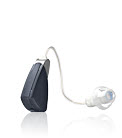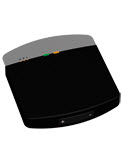Interview with Jenny Groth, M.A., Director of Audiology Communication, ReSound
Topic: Wireless Hearing Aid Technology - Misconceptions & Facts

Jennifer Groth
CAROLYN SMAKA: Hi Jenny, thanks for your time today. What do you do for ReSound?
JENNY GROTH: I'm an audiologist and I've been with the company for 15 years in various capacities, mostly in our clinical research department. We have two clinical research sites: one in Denmark and one in Glenview, Illinois. I head up the Glenview site.
SMAKA: Great. Thanks for talking to me about wireless hearing aid technology.
One misconception I hear both from professionals and consumers lies around Bluetooth. "Which hearing aids are Bluetooth?" is a common question.
Where do you think the confusion comes from?
GROTH: I think part of the confusion may be due to consumer marketing, which doesn't always make a very clear distinction between the hearing aid wireless technology and Bluetooth. You'll see hearing aid marketing that says "Bluetooth compatible", or even "Bluetooth hearing aids". Since the wireless hearing aid products available can interface with Bluetooth in some way or another, it's not quite accurate but it's not wholly inaccurate either.
There are no hearing aids today that directly implement Bluetooth. So, every hearing aid that claims to be able to utilize Bluetooth has some sort of intermediate device that interprets the Bluetooth signal and then changes the information into a wireless technology that the hearing aid can accept and transmit.
SMAKA: Why is Bluetooth not implemented directly in hearing aids?
GROTH: One of the reasons is power. Bluetooth requires a lot of power to operate, and could not be practically supported by a button cell battery.
Bluetooth was designed to support many applications for wireless communication, in addition to audio streaming. In terms of audio transmission, Bluetooth isn't a very efficient protocol because it has an inherent delay. So, with hearing aids, if you're streaming from an audio source, like a television, that sound will combine with sound that is entering the hearing aid microphone, or entering the ear directly via vents or an open earmold. In this instance, the delay that you might have with a Bluetooth transmission may have negative effects on the overall sound quality.
Therefore, even barring the power consumption issue, Bluetooth is not the ideal hearing aid technology for audio streaming.
SMAKA: So if Bluetooth is not implemented directly in hearing aids today, can you tell me about the wireless technologies that are in hearing aids?
GROTH: Sure. The first hearing aids with wireless technology that came out work on near-field magnetic induction (NFMI), and those can interface with Bluetooth using an intermediary device. But they also have to interface with audio sources to accept Bluetooth information. If the audio source is Bluetooth enabled, it can communicate to the intermediary device. If the audio source is not Bluetooth-enabled, another device would be required to send a Bluetooth signal from the audio source to the intermediary device.
For example, if you wanted to listen to your TV wirelessly through your hearing aids equipped with NFMI, and your TV was not Bluetooth enabled, you'd have to first hook up a device to your TV in order to send a Bluetooth signal to the intermediary device. Then, the intermediary device would send the signal to your hearing aids via NFMI. In this case, the intermediary device has a loop that works just like an induction loop. The loop creates a kind of 'magnetic bubble' around the listener and this near-field magnetic network is picked up by an antenna in the hearing instruments.
As long as you're within that little bubble, or near field network, which is about 30 inches from the intermediary device, then your hearing aids will pick up that signal.
SMAKA: That explains why these intermediary devices were meant to be worn around the neck or kept in a pocket - close to the listener.
GROTH: Exactly. In addition to NFMI, there are currently two systems on the market that use radio frequency (RF) transmission. With RF technology, the accessories or devices that send information to the hearing aid can be further away from the hearing aids since RF technology has a longer range than NFMI. Depending on the device you're connecting to, that distance can range from a few feet to up to 30 feet away. The information is sent directly to the hearing aids, without having to use an intermediary device in your pocket or around your neck.
Current RF systems use either the 900 MHz or the 2.4 GHz license-free ISM (Industry Science Medical) bands. The ReSound system uses the 2.4 GHz ISM band as it can be used internationally, while the 900 MHz ISM band is limited to use in certain areas including the Americas, Greenland, and some eastern Pacific Islands.

Graph showing transmission distance between ReSound's 2.4 GHz wireless technology as compared to NFMI.
SMAKA: You mentioned that an intermediary device - whether that's referred to as a relay device, streamer, medallion, etc. - is always needed with NFMI wireless hearing aids for audio streaming.
GROTH: Right. An intermediary device is always needed with NFMI technology, but not with RF technology.
SMAKA: Which ReSound products utilize RF technology?
GROTH: Our ReSound Alera™ product family, including the new form factors, utilizes RF wireless technology.

ReSound's Alera family of products feature wireless technology
SMAKA: You mentioned that the ReSound system uses 2.4 GHz, which also happens to be the same frequency as Bluetooth. What is the difference between the ReSound wireless technology and Bluetooth?
GROTH: The difference is in the protocols for wireless transmission. A protocol refers to the rules or the technical way that information is exchanged or transmitted between devices. The Bluetooth protocol is very broad because it has to accommodate any kind of wireless application it may need, whereas for the ReSound hearing aids, we have a dedicated wireless transmission protocol. Our protocol only takes into account what we want it to do, so it is very lean, has a lot less power consumption than Bluetooth, and it also allows us to control for privacy. So, there isn't any danger of anyone hacking into our wireless system to listen in on what's going on with your hearing aids. The principles of the wireless transmission are the same in that we're operating in the same frequency band and using the same sorts of techniques for avoiding interference.
SMAKA: With RF technology, how does it interface with Bluetooth?
GROTH: In the case of Bluetooth, there is a little accessory available that you wear that lets the Bluetooth talk to the Resound RF technology, and it includes a microphone for telephone conversations.
SMAKA: What are the advantages and disadvantages of both wireless hearing aid technologies - NFMI and RF - from the perspective of the hearing aid wearer?
GROTH: For NFMI, the main disadvantage is that the user must wear an intermediary device for wireless communication with audio or data sources, like watching TV or having the hearing aids fit wirelessly. In addition, all but one of the NFMI systems on the market today use Bluetooth for audio streaming to the intermediary device and, as we talked about, this introduces a delay which can negatively affect sound quality or even disrupt the synchronization between audio and video when the user watches television.
Manufacturers' implementations of the existing NFMI systems have also chosen to use the body-worn intermediary device for many different functions: as a remote control, to accept streaming from the television and other devices, and for cell phone communication via an integrated microphone. Patients who frequently use all this functionality may consider it advantageous to have one accessory to carry. With our system, however, we have chosen to make dedicated accessories rather than combining functionality into one device. That is not due to the RF technology, but rather due to a design decision, as we wanted to make each accessory as simple to use as possible. An interesting thing that came up in researching how hearing instruments with digital wireless features were being dispensed was that audiologists targeted younger users as candidates because of the complexity. We wanted the benefits of wireless to be accessible to all hearing instrument users.
As we mentioned, a major advantage to the RF wireless systems is the distance of the transmission. Our market research told us that the ability to transmit directly from audio and data sources to the hearing instruments would have the greatest impact in terms of user benefit. This is why we initially have prioritized solutions that do this over ear-to-ear transmission, which will come later. In addition, with the RF devices that are on the market today, the accessories can broadcast to many different hearing aids at the same time. So for example, a husband and wife who are wearing Alera can both receive the wireless signal from the same accessory which is connected to their television. With the near-field magnetic induction systems, they'd each have to have their own streamer for the TV, and they'd each have to have their own streamer for the phone and so on in addition to their individual body-worn intermediary devices, so there is a real convenience aspect to RF devices in this regard.
One advantage of NFMI systems that bears mentioning is that they have lower power consumption while you're using the wireless functionality, and that is related to the lower frequency at which they operate. The higher up you go in frequency, the more data you can transmit, and the more power you'll also consume.
SMAKA: Is either NFMI or RF technology more or less susceptible to interference?
GROTH: It's a common question. With a near-field magnetic induction system, you will often hear people say that they don't have interference issues, and as long as you're talking about the transmission from the intermediary device to the hearing aids, that's true. You're very unlikely to have any interference there at all. However, NFMI systems still use a 2.4 gigahertz Bluetooth-based transmission between the intermediary device and the external audio source whether that's a mobile phone, computer, etc. Across the board, any wireless hearing aids, whether they use NFMI or RF will have the same potential for interference. That said, they all use a similar strategy for avoiding interference, which is called spread spectrum frequency hopping.
Spread spectrum frequency hopping means that the transmission will jump around among a certain number of frequencies in the transmission band in order to avoid bumping into other things. The higher up in frequency you go, the easier it is to avoid the interference because we can send a lot more information in smaller amounts of time with the higher frequencies. It's the same sort of strategy that Bluetooth technology uses, it is a well tested and well established method for avoiding interference and it works pretty well.
SMAKA: I wanted to ask you about the utilization of wireless hearing aids and how they are being embraced by different demographics.
GROTH: I can speak about our products a bit. We are seeing that just about every fitting with wireless technology has an accessory purchased along with it. The TV streamer is a huge hit with anyone who is fit with hearing aids with wireless technology, and the phone accessory is utilized more by younger people who are still active in business.

ReSound UniteTM TV streamer is a very popular accessory, enabling direct transmission of sound from the TV to the listener's Alera hearing instruments.
SMAKA: Makes sense - who doesn't watch TV?
GROTH: Exactly.
SMAKA: Jenny, our discussion has certainly helped me to better understand wireless hearing aid technology, thanks again.
GROTH: It's been my pleasure.
For more information about ReSound, visit https://www.gnresound.com/ or the ReSound web channel on AudiologyOnline.


